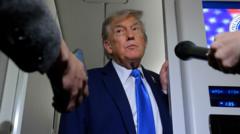As NATO prepares for its next summit, it grapples with balancing military commitments while keeping President Trump's approval, leading to a potential shift in spending and strategic goals.
**NATO Faces Challenges to Align with Trump's Demands Amid Upcoming Summit**

**NATO Faces Challenges to Align with Trump's Demands Amid Upcoming Summit**
NATO leaders are strategizing for the upcoming summit, focusing on military spending and Trump’s preferences.
In the wake of rising tensions surrounding military commitments, NATO leaders are under pressure to appease President Donald Trump at the forthcoming summit, set to begin shortly. As officials finalize plans for the conference, which will take place in The Hague and conclude in just two days, there is growing concern about effectively managing Trump's expectations related to military spending.
Historically, NATO has projected unity and strength in its operations, yet the current climate requires a more nuanced approach. Allies are diplomatically modifying their public stance on Ukrainian membership to align with Trump’s demands for increased military expenditure. The impending communiqué, characterized by its brevity, exemplifies this effort, consisting of only five paragraphs to minimize any potential friction with the U.S. leader.
Mark Rutte, NATO’s Secretary-General, has been at the forefront of advocating for an increase in military budgets across the 32 member nations. Trump has called for an ambitious rise of military spending to 5% of each nation’s gross domestic product—a notable jump from the current 2%. Rutte's proposal aims to recast military expenditure definitions to meet this goal, suggesting that 3.5% be dedicated to core defense initiatives, with the remainder accounted for under a broader “defense and security-related investment” umbrella.
Despite these attempts, experts and government officials have identified several shortcomings in this strategy. The timeline for implementing such significant increases may vary across different nations, and ambiguity around the specific requirements has created confusion. Furthermore, there are concerns regarding whether European and American defense sectors can effectively absorb these financial allocations and deliver the expected military enhancements in a timely manner.
As global uncertainties persist, NATO’s ability to navigate these challenges while maintaining cohesion among members will be critically examined amid the spotlight on Trump's notable influence. As the summit approaches, the delicate balancing act of addressing security issues and catering to Trump's expectations remains a pivotal focus for the alliance.
Historically, NATO has projected unity and strength in its operations, yet the current climate requires a more nuanced approach. Allies are diplomatically modifying their public stance on Ukrainian membership to align with Trump’s demands for increased military expenditure. The impending communiqué, characterized by its brevity, exemplifies this effort, consisting of only five paragraphs to minimize any potential friction with the U.S. leader.
Mark Rutte, NATO’s Secretary-General, has been at the forefront of advocating for an increase in military budgets across the 32 member nations. Trump has called for an ambitious rise of military spending to 5% of each nation’s gross domestic product—a notable jump from the current 2%. Rutte's proposal aims to recast military expenditure definitions to meet this goal, suggesting that 3.5% be dedicated to core defense initiatives, with the remainder accounted for under a broader “defense and security-related investment” umbrella.
Despite these attempts, experts and government officials have identified several shortcomings in this strategy. The timeline for implementing such significant increases may vary across different nations, and ambiguity around the specific requirements has created confusion. Furthermore, there are concerns regarding whether European and American defense sectors can effectively absorb these financial allocations and deliver the expected military enhancements in a timely manner.
As global uncertainties persist, NATO’s ability to navigate these challenges while maintaining cohesion among members will be critically examined amid the spotlight on Trump's notable influence. As the summit approaches, the delicate balancing act of addressing security issues and catering to Trump's expectations remains a pivotal focus for the alliance.




















